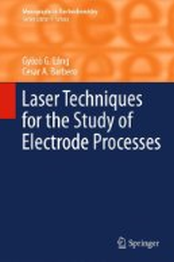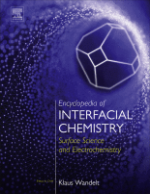
Laser Techniques for the Study of Electrode Processes
The book authored by
G.G. Láng and C. Barbero
is published by Springer (2012, Berlin–Heidelberg) in the series of Monographs in Electrochemistry (series ed. Fritz Scholz).
About the book:
Laser-enabled measurements are valuable tools for the investigation of surfaces and interfaces or for the in situ investigation of interfacial processes including electrode processes. The understanding of the thermodynamics of solid/liquid surfaces is important for surface science and electrochemistry. In the first part of this book, the authors describe a range of techniques for investigating interfacial tension and surface stress, which is important for coatings, thin films, and fuel cells. The techniques covered comprise bending beam (bending plate, bending cantilever, wafer curvature) methods with different detection techniques. Special attention is given to methods using optical detection by laser beam deflection or interferometry. The second part is devoted to the techniques based on the detection of refractive index gradients in the solution. The refractive index changes could be related to concentration gradients (Probe Beam Deflection, PBD) or light-induced thermal gradients (Photothermal Deflection Spectroscopy, PDS). The application of the techniques to surface-confined and solution electrochemical systems is described. Subsequently, a comparison with others techniques able to monitor ion fluxes is performed.
Get full document:
Preface:
For the study of electrode processes, the application of lasers has proved to be very successful. Győző Láng (Budapest, Hungary) and Cesar Barbero (Rio Cuarto, Argentina) have undertaken the task to present the use of lasers (1) for studies of interfacial stress changes of solid electrodes and (2) for the study of changes of the refractive index of solutions near electrode surfaces. The first part of the monograph contains a very sound discussion of the thermodynamics of electrode surfaces, as it can be hardly found elsewhere. The entire monograph excels in a clear presentation of the theoretical background, the experimental setups, and well-chosen illustrative examples. This book will be an indispensable reading for postgraduate students and scientists wishing to use these laser techniques in electrochemical investigations. The two authors have decisively contributed to the development of the presented techniques, and their in-depth knowledge guarantees that the reader gets an authoritative and reliable source which will be valid for many years to come.Prof. Dr. Fritz Scholz, editor of the series: Monographs in Electrochemistry
From the reviews:
"This is a well-written book, excelling in the rigor of presentation and in detailed reference lists at the end of each chapter, for the convenience and extended study of each subject discussed."
E. Gileadi, J Solid State Electrochem, Vol. 17, p. 2377, 2013
